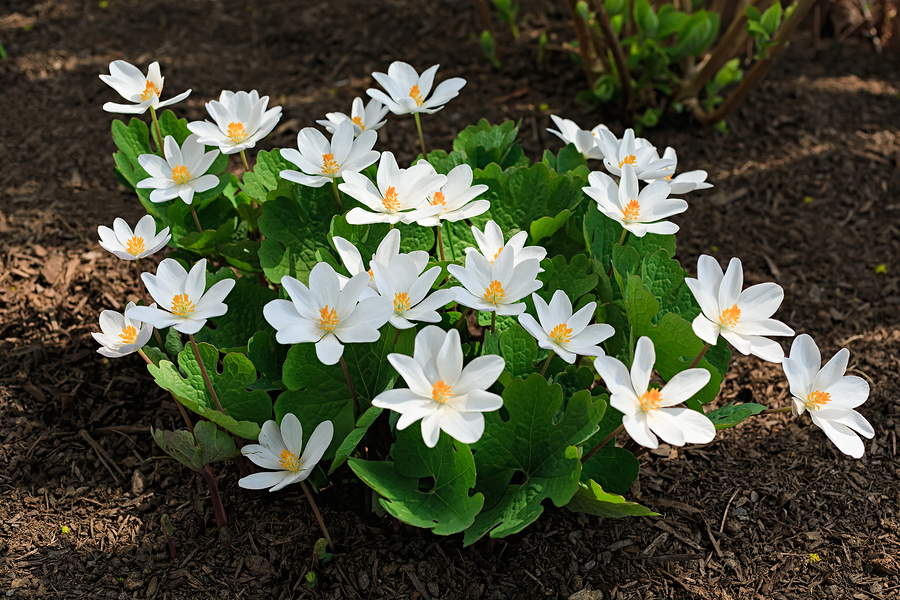Know Your Remedies: Sanguinaria Canadensis (Sang.)
 Common Names: Bloodroot; bloodwort; Canada puccoon.
Common Names: Bloodroot; bloodwort; Canada puccoon.
General Information
The symptoms of those needing Sanguinaria Canadensis (Sang.) are usually right-sided (especially headaches) and often improve with burping, vomiting, or passing flatus (gas). The person is warm-blooded and complains of burning, congestion, and flushes of heat. They feel worse in the daytime sun. Mucous membranes are often dry though any discharge will be burning or acrid. A strong liking for spicy or pungent food is common.
Mental-Emotional Symptoms
- Sensitive to light, noise, and odours.
- Want to be held. Feel better for being held.
Head
- Nearly all headaches and migraines are right-sided.
- Weekly headaches/migraines.
- Headaches/migraines that commence in nape of the neck and settle over the right eye.
- Headaches/migraines with burning in the stomach.
- Headaches/mograines relieved by vomiting.
- Headaches/migraines in which the eyes feel as though they are being pressed out.
Nose
- Sensitive to odours.
- Acrid discharges.
- Hay fever.
- Polyps
Chest and Respiratory
- Cough that is improved by burping or passing flatus (gas.)
- Cough that improves with vomiting.
- Asthma with heartburn.
Gastrointestinal
- Eosophagitis
- Vomiting with headaches or migraines.
Limbs
- Pain in right shoulder, on raising or turning arm.
- Shoulder pain that worsens at night. Bursitis.
- Heat and burning of palms or soles.
- Feet become hot at night – have to poke them out from under the covers.
Where do I find it?
Sanguinaria Canadensis (Sang.) is available from our online store as a single remedy in either pills or liquid, and as part of the following Complex (combination remedy): Rotator Cuff & Shoulder Pain.
Home Treatment Guidelines
Acute, Self-Limiting Conditions
Conditions like colds or minor injuries, which are short-term and typically improve on their own, can be managed at home with homeopathy. However, in emergencies or if symptoms worsen, contact your healthcare provider.
Chronic Conditions
These home treatment instructions do not apply for ongoing issues, whether mentioned above or not, like persistent allergies or chronic pain. You should consult a qualified homeopath for a personalized treatment plan to achieve the best results with homeopathy for chronic conditions.
How to Take the Remedy for Acute Conditions
- Take one pill or five drops of the remedy. The frequency depends on symptom severity. As examples:
- For life-threatening symptoms, take every 1 minute and seek emergency help immediately.
- For mild symptoms, take every 4 hours.
- Stop taking the remedy once you feel better. Resume if symptoms return.
- If no improvement after four doses, choose a different remedy or consult a professional homeopath.
- For more details on dosing, refer to: How Often to Dose with a 30C Homeopathic remedy.
- For information on the different potencies, read: Guidelines on which potency to use
Additional Notes From Past Masters
Homeopathy is a 200-year-old system of medicine. Early homeopaths recorded detailed notes on how remedies worked, including initial tests, remedy relationships, and their experiences. These writings were shared to improve homeopathic practice and now offer fascinating insights into past uses of homeopathy. Here’s an example, edited and modernised for clarity, from Leaders In Homoeopathic Therapeutics (1898) by E. B. NASH M.D.:
Leaders In Homoeopathic Therapeutics by E. B. NASH M.D.
Sanguinaria Canadensis
Pain beginning in occiput; spreads over the head and settles over the right eye, with nausea and vomiting. Sensitive to noise and light.
Loose cough with badly smelling sputa; the breath and sputa smell badly to the patient himself.
Pain in right arm and shoulder; worse at night in bed; cannot raise the arm. Also pain in places where the bones are the least covered.
Heat and tension behind sternum. Cough day and night with great emaciation.
Burning and pressing in breast, followed by heat through abdomen and diarrhoea. Acts intensely on right lung and chest.
* * * * *
Sick headache. Pain commences in the back of the head, rises and spreads over the head, and settles down over the right eye (left eye, Spigelia), with nausea and vomiting; patient wants to be in a dark room and perfectly quiet.
I have made some fine cures in long-standing cases of habitual sick headaches of this kind with this remedy. It will probably cure, or greatly relieve, the ordinary American sick headache as often as any other remedy. I use the 200th.
Loose cough, with badly smelling sputa; the breath and sputa smelling badly to the patient himself. There is sometimes a pain behind the sternum (Kali hydroid.). This kind of cough usually comes on after a severe bronchitis or pneumonia, and it looks as though the patient were fast running into consumption.
There may also be flushes of fever with circumscribed redness of the cheeks, like hectic fever. Many a case of this kind has been helped by this remedy. Dr. T. L Brown used the first trituration of the alkaloid with fine effect. The 200th has made just as good cures.
In typhoid pneumonia with great dyspnoea and circumscribed redness of the cheeks, Sanguinaria has, in my hands, done good service. The right lung seems to come markedly under its influence, either in acute or chronic troubles.
“Rheumatic pain in right arm and shoulder, worse at night in bed, cannot raise the arm.” This condition has often been relieved by this remedy in my hands and has won me much credit. I have seen one dose of the first trituration cure such cases of long standing. I have seen the c.m. do the same thing.
Flashes of heat, with hot palms and soles, at the climacteric find a remedy in Sanguinaria. Sometimes indicated after Sulphur and Lachesis have failed, especially if the circumscribed redness of the cheeks appears.







